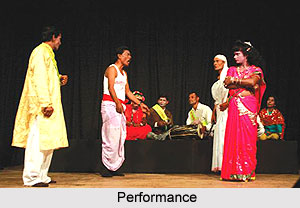 Alkap is a rural performance popular in many places of West Bengal, especially in Rajshahi, Malda district, and Murshidabad districts, and the Rajmahal Hills in Jharkhand state. This is associated with the Gajan festival of Lord Shiva around the middle of April. The word Kap refers to Gambhira and the Bahurupi impersonators. Several opinions exist about the origin of the word, but all place the beginnings of this form in the late nineteenth century. It has no written script but scenarios based on popular love stories, which the actors elaborate with extempore dialogues, breaking up for songs, dances, and comic or satirical sketches called kap. Leaning totally on improvisation, it remains open-ended and can continue for days.
Alkap is a rural performance popular in many places of West Bengal, especially in Rajshahi, Malda district, and Murshidabad districts, and the Rajmahal Hills in Jharkhand state. This is associated with the Gajan festival of Lord Shiva around the middle of April. The word Kap refers to Gambhira and the Bahurupi impersonators. Several opinions exist about the origin of the word, but all place the beginnings of this form in the late nineteenth century. It has no written script but scenarios based on popular love stories, which the actors elaborate with extempore dialogues, breaking up for songs, dances, and comic or satirical sketches called kap. Leaning totally on improvisation, it remains open-ended and can continue for days.
It is a composite performance comprising acting, dancing, singing and recitation. An alkap group consists of ten to twelve artistes, led by a Sarkar or guru. The group also includes two or three young men called chhokras and one or two gayens or singers. The rest comprise dohar, choristers, and musicians. Alkap performances take place at night on an open stage, which is lit by lanterns, popularly known as hyajak bati. The audience stands or sits around the stage, leaving a narrow passage for the performers. Early Alkap i.e. in the time period between the years 1890-1920 resembled Gambhira in invoking Siva at the asar bandana i.e. benediction to the session and referring to him in the kaps. The preliminaries included a prayer to the Goddess Saraswati and were succeeded with a dance by gaudily dressed women or cross dressed males. Dhols, cymbals, and flutes provided accompaniment and a "concert" before the performance to gather an audience. The audience sat around a makeshift acting area, often marked by two posts from which hung lanterns or Petromax pressure lamps. There were no green rooms or even a passage for entrances, so no scope of changing costumes or make-up during the show. The female characters who took part in the first dance wore those same dresses throughout. The cast, adept at physical acting, marked entries and exits just by getting up and sitting down respectively. The troupes had up to a dozen personnel.
The Indian folk art form Alkap broke away from religious festivals early in its history to become a poor rural cousin of city-bred Jatra. It has almost merged with the Pancharas that is the recent productions by professional companies aimed solely at entertainment using proscenium stages, electronic gadgets at village fairs as well. Unlike Jatra, extemporaneous conversations while following a storyline based on popular romantic tales often a take-off from commercial Bengali cinema or Hindi films (Bollywood).
There are two main parts of an alkap performance. These are songs and witty dialogue in prose or verse. Usually, the themes of the songs are drawn from mythological tales, particularly the story of Radha and Lord Krishna, while the subjects of the dialogue relate to contemporary social events. Sometimes the audience also joins in. The main attraction of alkap performances, however, is the chhokras who dance, dressed as girls, between the singing and acting. Handsome boys are trained to become chhokras and become quite expert in performing the salacious dances known as khemta and jhumur. There are also clowns to make the audience laugh. The singers sit on the stage while the musicians sit below the stage, on one side. The instruments that accompany the alkap performance are the drum, harmonium, tabla, tambourine, flute etc. The musicians sit throughout the performance. The sarkar enters first, singing a vandana or hymn. He then recites verses that introduce the main theme of the drama. Then he and the main singers start the alkap, while the choristers help them by repeating the burden of the song.
Though the alkap is similar to the jatra, it is more of a song-and-dance performance than the jatra, which is closer to a play. The actors in a jatra have designated parts and a set dialogue to speak. In the alkap, however, the performers have a notion of the storyline improvisation on stage. The attraction of the alkap lies in the vulgar jokes and sexual dances, which also make it necessary for alkap performances to be staged late at night and at some distance from the village. At present, when television and films have reached the remotest villages, the popularity of the alkap has decreased and it is on its way to extinction. This is unusual folk form, which is the signature art of Bengal.




















